The best height-adjustable seatposts reviewed and rated by BikeRadar’s expert testers
The best dropper posts are a good example of how fast and far mountain bike technology evolves. Fewer than 10 years ago, dropper seatposts were a relative rarity, but it’s near impossible to find a mountain bike without one now.
A dropper post is a telescopic seatpost that, at the touch of a button, lowers your saddle out of the way, improving control and comfort in steep or technical terrain.
A dropper post is a must-have these days if you’re riding anything remotely technical, opening up a far wider range of riding – without having to stop and manually move your post up and down when tackling steep trails.
Our expert team of testers have reviewed dozens of dropper posts, and this list represents the best of the best. Whether you’re looking to fit a dropper post to your bike for the first time or upgrade your current dropper, you’ll find something here.
For more information, read our full buyer’s guide to dropper posts at the bottom of this article.
Which are the best dropper posts?
Crankbrothers Highline 7
- Price: £270 / $299 / €299 as tested
- Weight: 516g (without remote and cable)
- Stroke length (* tested): 100mm, 125mm*, 150mm, 170mm
- Diameters: 30.9mm, 31.6mm
- Max length: 417mm (125mm travel)
Crankbrothers has nailed the performance, reliability and ease of fitment with the Highline 7.
The post’s construction screams quality and it was very simple to fit to our test bikes thanks to the cable’s nipple attaching to the post end, with the lever clamping the cable at the other end.
The stack height – the distance from the bottom of the post’s collar to the centre of the seat rails – was impressively short at 50mm, too.
Although the remote was £55 extra, we thought it was well worth it, thanks to its smooth action and adjustable angle.
OneUp V3 Dropper Post

- Price: £290 / $270 / €300 as tested (plus £44.99 / $44.99 / €49.99 for OneUp Dropper Post Remote V3)
- Weight: 488g (without remote and cable – remote: 29g)
- Stroke length (* tested): 90mm, 120mm, 150mm, 180mm*, 210mm, 240mm
- Diameters (* tested): 27.2mm, 30.9mm, 31.6mm*, 34.9mm
OneUp’s latest dropper post offers incredible performance, with easy actuation and setup making for a post that’s easy to live with.
At 488g, the post competes with some of the lightest droppers on the market and the replaceable air cartridge means easy servicing.
A lower stack height than on the previous generation enables you to drop the seat even lower.
OneUp V2 Dropper Post

- Price: £179 / $199 as tested (plus £42 for OneUp Dropper Post Remote V2)
- Weight: 579g (without remote and cable – remote: 48g)
- Stroke length (* tested): 120mm, 150mm, 180mm, 210mm*
- Diameters (* tested): 30.9mm*, 31.6mm, 34.9mm
- Max length: 554mm (210mm travel)
The OneUp V2 dropper features an exceptionally compact post body, seal head and seat clamp. This enables OneUp to pack in 210mm of travel into a small overall package that beats the competition.
To boot, the V2 doesn’t cost a fortune and we had no issues with it sticking or feeling lumpy during the testing period.
RockShox Reverb AXS

- Price: £750 / $861 / €886 as tested
- Weight: 708g (66g for remote)
- Stroke length (* tested): 100mm, 125mm, 150mm, 170mm*
- Diameters (* tested): 30.9mm, 31.6mm*, 34.9mm
RockShox’s Reverb was one of the first electrically actuated dropper posts on the scene, and this latest iteration provides a fast, responsive and refined drop that is hard to match.
The ergonomics of the lever and fast return make using the dropper a pleasure, with our tester finding they dropped the post more often than usual with the Reverb.
It would be good to see longer stroke lengths for taller riders.
BikeYoke Divine

- Price: from £270 / $289 / €300 as tested (plus from £45 / €45 for remote)
- Weight: 491g (30.9x160mm)
- Stroke length (* tested): 125, 160*, 185mm (adjustable in 5mm increments)
- Diameters (* tested): 30.9*, 31.6mm
- Max length: 517mm (185mm travel)
BikeYoke’s Divine is one of the best posts out there – the less sophisticated hydraulics make it a little cheaper, but more importantly, enables easy travel adjustment.
It still has the German brand’s auto-refresh mechanism, to ‘bleed’ itself and prevent sponginess, along with its super-slim collar.
The neat ability to twist the bottom activator out of the way of bottle bosses and other seat tube interruptions allows for maximum insertion. You can reduce the drop in 5mm increments using the included spacers.
Because of higher operating pressures, the longer Triggy Alpha remote is recommended to exert more leverage.
The return speed won’t be as fast as some riders prefer, but this is a top-quality, lightweight post that’s smooth, easy to service and totally reliable.
BikeYoke Revive 2.0

- Price: £299-£365 as tested (without dropper lever)
- Weight: 642g
- Stroke length (* tested): 125mm, 160mm, 185mm, 213mm*
- Diameters (* tested): 30.9mm, 31.6mm*, 34.9mm (Revive Max)
- Max length: 397mm (125mm travel), 467mm (160mm travel), 517mm (185mm travel), 582mm (213mm travel)
As far as we are aware, the BikeYoke Revive 2.0 is the longest dropper post on the market with 213mm of travel and a 582mm max length in its biggest size, which is good news for those with long legs.
The low stack height keeps the post out of the way when it’s down, providing plenty of room to move your body around when descending.
The BikeYoke Revive 2.0 has always been praised for its smooth action, and our testing led us to think that this could well be the best feeling cable-operated dropper around, with a precise and light lever feel.
The BikeYoke Revive 2.0 doesn’t come with a dropper lever included, and this will cost an extra £65 on top of the initial £299–£365 outlay (depending on stroke length).
Finally, the post doesn’t use an IFP (internal floating piston) like some other brands. This means fewer seals, less friction and less to go wrong, but it does mean the oil can mix with the air resulting in sponginess. A 4mm bolt underneath the saddle clamp makes it easy to refresh the post, but the necessity of this could be offputting for some.
Bontrager Line Elite
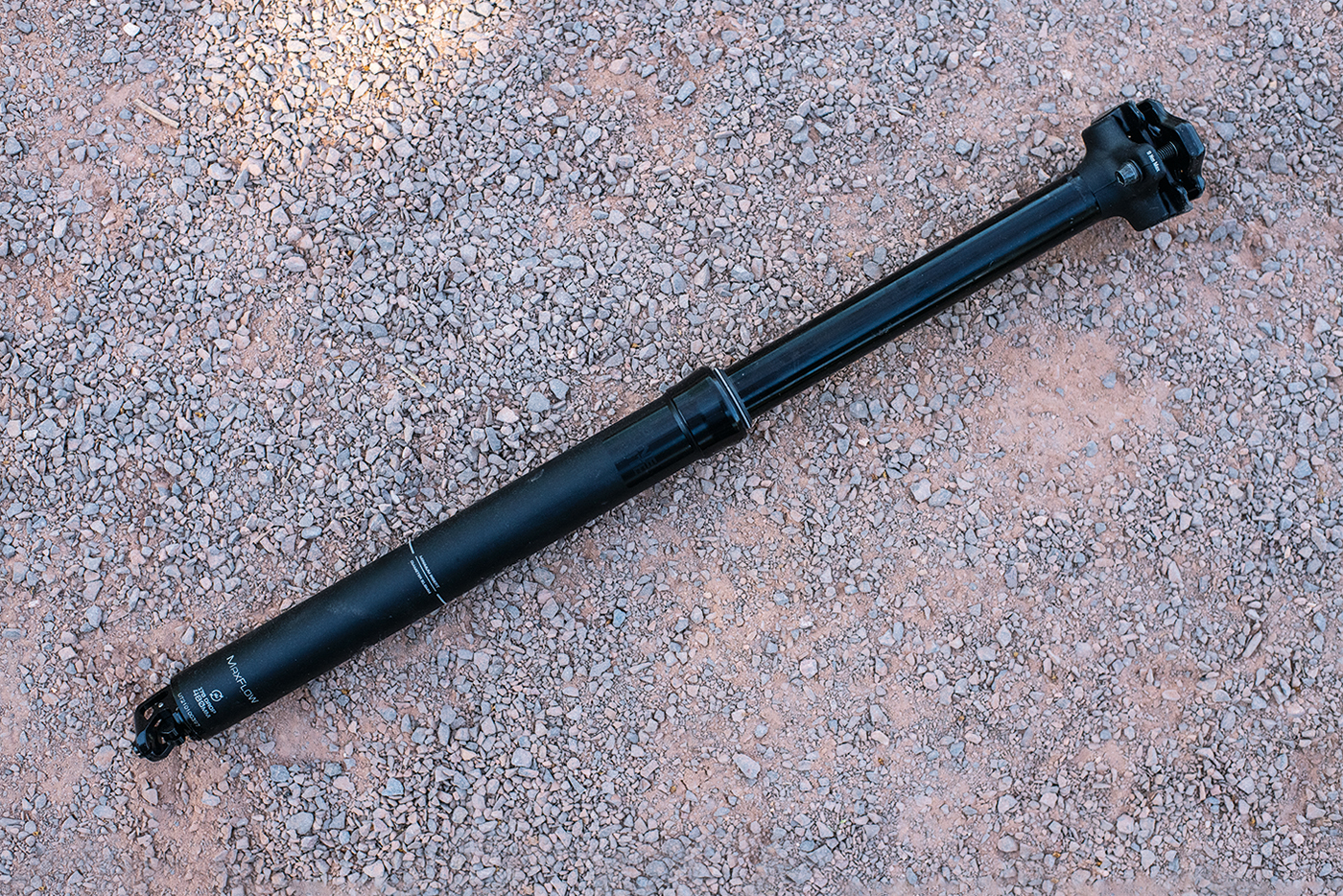
- Price: £300 / $330 / AU$440/ €350 as tested
- Weight: 558g
- Stroke length (* tested): 100mm, 130mm, 150mm, 170mm*
- Diameters (* tested): 30.9mm, 31.6mm*, 34.9mm
- Max length: 340mm (100mm travel), 400mm (130mm travel), 440mm (150mm travel), 480mm (170mm travel)
The Bontrager Line Elite is the higher-specced of two dropper seat posts from the brand, with the lower being the Bontrager Drop Line.
This model has Bontrager’s MaxFlow cartridge, which makes for faster and smoother action.
The price includes a dropper lever, which works with Shimano I-spec and SRAM Matchmaker levers, but we found the lever to feel spongy when using it in testing.
This dropper post has a greater stack height than others at 62mm, providing less clearance when the post is dropped.
A nice touch is the adjustable travel height. You can change the travel by 10-30mm by placing a spacer underneath the post’s collar.
Overall, the Bontrager Line Elite is hard to fault, performing without issue in testing and proving easy to install.
Brand-X Ascend II

- Price: £140 / $150 / €155 / AU$220 as tested
- Weight: 618g (without remote and cable)
- Stroke length: 150mm
- Diameters: 27.2mm, 30.9mm, 31.6mm
- Max length: 390mm (105mm travel), 400mm (125mm travel), 449mm (150mm travel)
Thanks to its cable barrel attachment at the post end, the Ascend II doesn’t require accurate trimming of the inner and outer cables. The Ascend II is an externally-routed cable dropper, although an internally-routed cable option — the Ascend XL — is also available.
The Ascend II impressed us on the trails with a near-perfect return speed, impressively shaped and easy-to-use remote, and reliable action. Although the supplied cable didn’t last long in wet conditions, suffering from corrosion, simply replacing it with a better quality cable would solve that issue.
Although the Ascend II is impressively cheap, it’s almost identical to Race Face Aeffect-R and Syncros post. If you’re after a bargain, then, look no further.
Brand-X Ascend XL
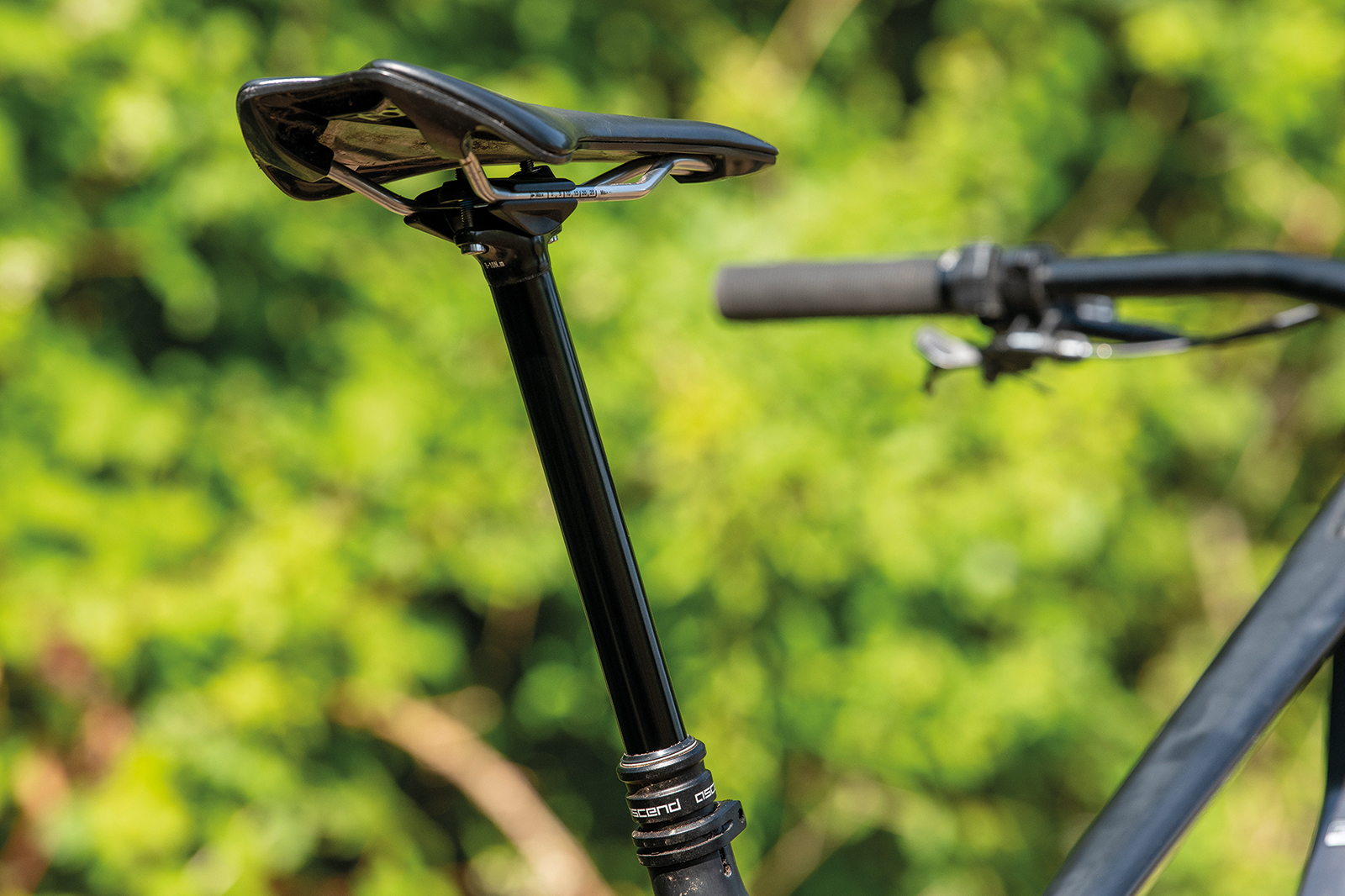
- Price: £170 / $180 / €190 / AU$275 as tested
- Weight: 668g
- Stroke length (* tested): 170mm, 200mm*
- Diameters (* tested): 30.9mm*, 31.6mm
- Max length: 499mm (170mm travel), 559mm (200mm travel)
Priced under £200 for a long-travel dropper, the Brand-X Ascend XL is hard to beat. The 200mm version, in particular, is a good bet for taller riders.
Brand-X has increased the shaft diameter and improved the internals in the Ascend XL for less flex and a smoother action.
The post comes with a shifter-style under-bar remote and internal cable routing, unlike the regular Ascend (also included in this guide), which has external routing.
Although the post isn’t light, it proved to be reliable over months of use. Stack height isn’t bad, but fitting might be an issue if you have a kinked or extra-tall seat tube.
Fox Transfer Performance Elite

- Price: £339 / $309 as tested
- Weight: 636g
- Stroke length (* tested): 100mm, 125mm, 150mm, 175mm*, 200mm
- Diameters (* tested): 30.9mm, 31.6mm*
- Max length: 308.6mm (100mm travel), 363.5mm (125mm travel), 418.3mm (150mm), 475.1mm (175mm travel), 530.7mm (200mm travel)
Fox has updated its reliable Transfer dropper post, reducing weight, insertion depths and adding a 200mm travel option. It’s also released a new 1x bar remote and has made internals easier to service.
One of our favourite new additions is the low-profile seat clamp which keeps the stack height at a minimal 44mm and frees up plenty of space to move your body around on steep descents.
Installation and adjustment are very easy and the cam-operated actuator makes for a light feel.
The new 1x remote was smooth throughout testing and can be mounted either directly to the bar or Shimano I-Spec or SRAM Matchmaker brake levers. The only downside is the lever isn’t included and will cost an extra £75.
KS Lev Circuit

- Price: £730 as tested
- Weight: 697g (42g for remote)
- Stroke length (* tested): 125mm, 150mm, 175mm*, 200mm.
- Diameters (* tested): 30.9, 31.6mm*
KS’s first electric dropper post provides great response and quick actuation.
The post is quick to drop when the wireless remote is pressed and returns with a fast, adjustable speed.
The Lev Circuit isn’t quite as refined as the RockShox Reverb AXS, with the remote feeling a little delicate and cheap.
We were impressed by the post’s consistency over prolonged use and the inclusion of a USB-C charger.
KS Vantage

- Price: £159.99 as tested (£34.99 for Westy 2.0 remote)
- Weight: 655g (42g for remote)
- Stroke length (* tested): 110mm to 140mm, 140mm to 170mm*, 180 to 210mm.
- Diameters (* tested): 30.9, 31.6mm*
KS’s Vantage dropper post offers high-end performance at a budget-friendly price.
Each post size has 30mm of adjustability via a hex bolt on the head, enabling you to get the most drop possible on your frame.
We found the post to be fast and precise when actuated, though we would spend a little more to avoid the Westy 2.0 remote.
Vecnum NIVO 212 TRAVELFIT

- Price: €427.93 as tested
- Weight: 530g (212mm post and remote)
- Stroke length (* tested): 122mm, 152mm, 182mm, 212mm*
- Diameters (* tested): 30.9mm*, 31.6mm, 34.9 mm
- Max length: 571mm
The Vecnum NIVO is available in four lengths and the 212mm version we tested is one of the longest-travel seatposts available on the market. That amount of travel is liberating for tall folk on bikes with rider-forward geometry.
The TRAVELFIT system allows you to shorten the travel in 4mm steps to find the perfect fit for your frame and the overall package is surprisingly light.
However, it’s a pricey option and we needed to up the pressure to the maximum allowed to get the post to reach full extension.
XLC All MTN SP-T13B

- Price: £209 / €169.99 as tested (inc. remote)
- Weight: 583g (30.9x150mm)
- Stroke length (* tested): 100, 125, 150mm* (adjustable in 5mm increments)
- Diameters (* tested): 30.9*, 31.6mm
- Max length: 459mm
The in-house brand of the huge Accell group (which distributes Raleigh, Lapierre and Haibike), XLC gets close to value-leaders Brand-X on price. With a maximum drop of 150mm, the SP-T13B isn’t the best for taller riders, but is internally adjustable in 5mm increments for perfect extension up to that height.
It has an excellent reliability record, which is unsurprising because there’s not much to go wrong with a sealed cartridge and an actuator that looks identical to the Ascend’s.
This post has a slightly more solid feel and smoother action, though. That’s due in part to less side-to-side shaft play, but also the stiffer and more positive-feeling forged-alloy, sealed-bearing ‘Blaster’ remote.
The collar isn’t the shallowest and the height markings look naff, but this is a proven product with a quality remote for a bargain price.
9Point8 Fall Line

- Price: £379 / $349 as tested
- Weight: 623g
- Stroke length: 75mm, 100mm, 125mm, 150mm, 175mm, 200mm
- Diameters: 30.9mm, 31.6mm
- Max length: 455mm
- Internal length: 245mm
One of the longest posts on the market, the Fall Line is light and loaded with great features, but we’ve had irritating leakage issues with our samples.
The ‘DropLoc’ cable shuttle needs to be set up exactly right, but having the cable anchored at the lever end makes it easier, and once you’ve got it sorted the whole mechanism can be unscrewed for easy removal/refitting.
There’s a wide range of stroke lengths, with super-long 175mm and 200mm versions available for an extra £40. It’s both lightweight and short for its travel.
The saddle clamp features large titanium bolts for security and separate angle adjustment, and there’s a layback head option for £35.
Whether you choose the ‘universal’ remote or the sweetly-machined shifter-style ‘Digit’ unit seen here, the action is very smooth. Return speed can be altered and stop-point modulation is excellent.
The 9point8 post has a great reputation for reliability too, although we’ve had gradual pressure leakage problems.
Crankbrothers Highline 11 Dropper

- Price: £400 / $400 as tested (£69.99 / $69.99 for Highline Premium Remote)
- Weight: 537g (37g for remote)
- Stroke length (* tested): 60mm, 80mm, 100mm, 125mm, 150mm, 170mm*
- Diameters (* tested): 30.9, 31.6mm*
The Highline 11 Dropper is quick and easy to set up and provides consistent dropping with quick return speeds.
A carbon quill is used alongside golden titanium hardware for the extra bling factor, though this had little impact on the post’s feel when riding.
Despite its best efforts, the post isn’t that competitive when it comes to weight savings, although it remained a good performer over a long test cycle.
Crankbrothers Highline XC/Gravel

- Price: £225 / $250 / €250 / AU$425 as tested
- Stroke length : 60mm, 80mm, 100mm, 125mm
- Diameter: 27.2mm
The Crankbrothers Highline dropper seatpost is designed for cross-country cycling and gravel riding, so it comes in a narrow 27.2mm diameter and with relatively short stroke lengths, at 60mm to 125mm.
There is a quick-connect system for the cable and, while this is straightforward, it’s worth spending some time to get the installation right.
Despite using the post through a wet winter, the seatpost action remained smooth and we found using it on a Santa Cruz Stigmata made a brilliant bike even better.
One of the most ingenious aspects of the Crankbrothers dropper system is the dual-action dropper lever, which can be used with your forefingers when riding on the top of the bars or by your thumb on the drops. Unfortunately, it isn’t included in the Highline’s price and will need to be purchased separately for £49 / $50 / AU$125.
e*thirteen Vario Infinite

- Price: £200 / $179 as tested
- Weight: 628g
- Stroke length (* tested): 120mm-150mm, 150mm-180mm*
- Diameter: 30.9mm, 31.6mm
- Max length: 535mm
e*thirteen’s post offers 30mm of tool-free travel adjustment in 5mm increments, without needing to remove the post from the bike. It’s quick and easy to adjust, although we questioned how often you’d change your travel after the initial setup.
The post’s stanchion and head are forged as a single piece to add rigidity, although the post did develop some play during testing. e*thirteen says its gas-sprung cartridge is designed to reduce the force needed to drop the saddle. We did find return speed a little slow though and it isn’t adjustable.
We really liked the Vario remote, which is sold separately for £50 and has an angle-adjustable paddle. It comes with a standard bar clamp and is also SRAM Matchmaker compatible.
Fox Transfer Factory 2020

- Price: £438 / $409 / €498 / AU$658 (including lever)
- Weight: 646g
- Stroke length (* tested): 100mm, 125mm, 150mm, 175mm*
- Diameters (* tested): 30.9mm, 31.6mm*
- Max length: 505.7mm
- Internal length: 298.5mm
If you can afford it, Fox’s Transfer is a robust, sweet-performing post that can be switched between internal and external routing.
It uses a typical hook-ended actuator lever design, but cable clamping and cutting are done at the lever end, making it a much easier process.
The light-action remote lever is available in under-bar shifter style or vertical ‘universal’ format too. You do have to buy that separately at £69 on top of the £369 post cost, which seems steep given its average, wobbly-from-new design.
Fox recently announced the addition of a 175mm stroke length post to the Transfer lineup, which is compatible with the Race Face 1x lever, and the new post and remote will cost the same as the other length models.
The function is silky-smooth though, with excellent speed and position control. Every Transfer we’ve used has stayed that way indefinitely, no matter how bad the conditions or minimal the maintenance.
That makes the high price a reasonable investment, and the Performance version skips the gold Kashima coating of the Factory post to save £50. You can even switch to external operation using an actuator at the collar.
KS LEV Integra
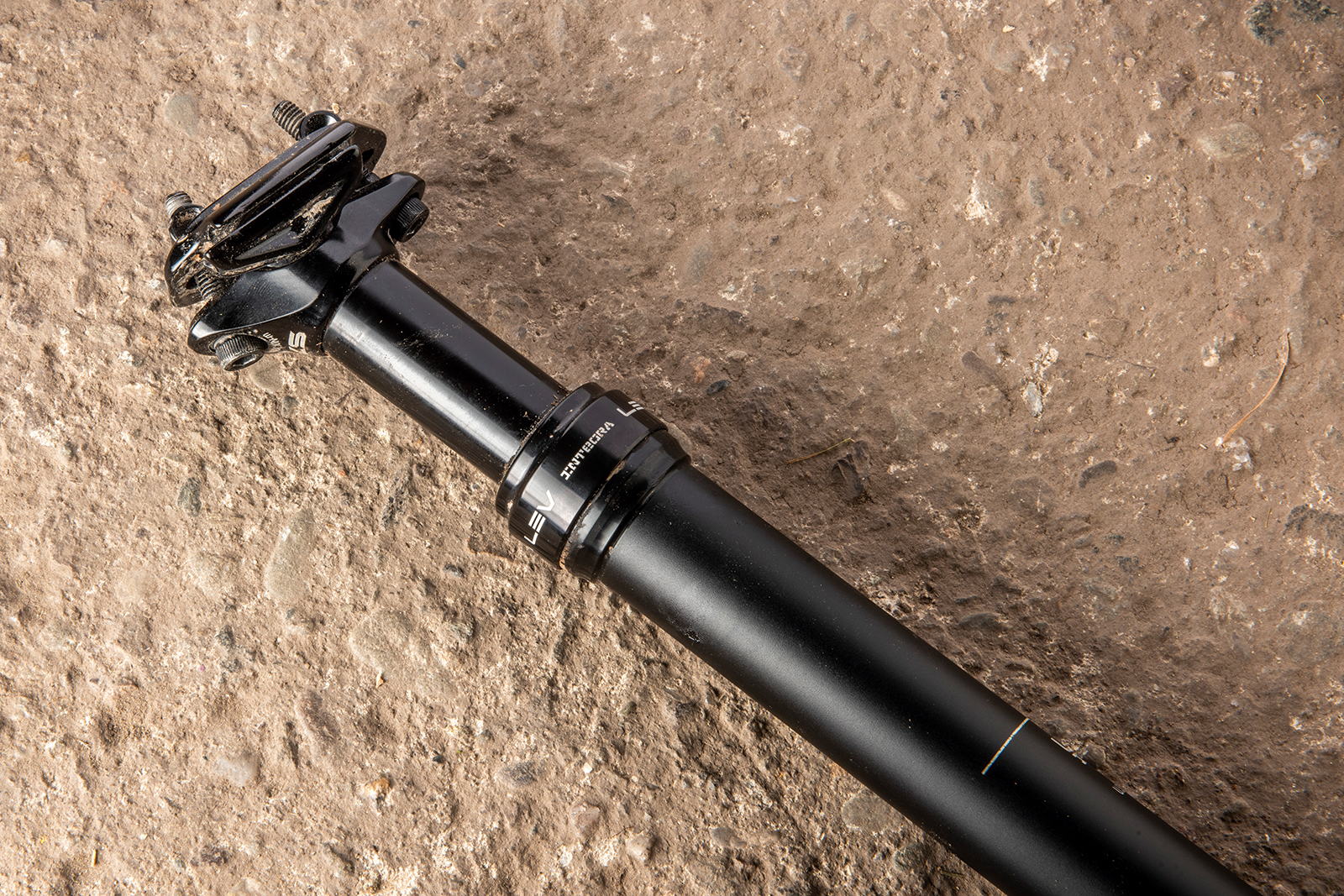
- Price: £290 / AU$500 as tested
- Weight: 484g (without remote and cable)
- Stroke length (* tested): 100mm, 125mm*, 150mm, 175mm
- Diameters: 27.2mm, 30.9mm, 31.6mm, 34.9mm
- Max length: 450mm
- Internal length: 250mm
KS’s LEV is light, well priced, flex-free, available in lots of options and more reliable than most of its rivals. It’s been on the market for a while now, so we’ve had plenty of time to work out what it is – and isn’t – good at.
Its large-diameter upper shaft means it flexes noticeably less than most posts when pedalling in longer lengths and on bikes with slack seat angles.
The low weight will appeal to XC/trail riders, and there’s even a 27.2mm version (100mm stroke) for hardtails and older frames. It’s got a smooth and easily controlled stroke with a solid top-out thunk that leaves no doubt that it has re-extended.
The way that the post extends if you pick the bike up by the saddle is a pet hate of some people. We do still occasionally get LEVs that need a nudge or pull to extend them too, but that’s less common than it used to be.
Our main criticism of the LEV is how the cable is mounted – it’s clamped at the post end instead of the lever. This means accurate cable tension and length is needed to get it working well and it takes longer to set up than posts where the cable is clamped at the remote end.
PNW Loam

- Price: £197 as tested (plus £65 for the Loam Lever Gen 2)
- Weight: 553g (46g for the remote)
- Stroke length (* tested): 125mm, 150mm, 170mm*, 200mm
- Diameters (* tested): 30.9mm, 31.6mm*, 34.9mm
PNW offers good value for money across its range of products and its Loam dropper post is no exception.
The Loam dropper comes with some nifty features, including customisable speed return and easy on-bike travel adjustment.
The 55mm stack height is reasonable and still leaves a decent amount of room to move around when the saddle is dropped.
There is noticeable side play when wiggling the saddle, which made the post feel less sturdy but did nothing to impact performance.
Syncros Duncan Dropper 2.0

- Price: £210 / $230 as tested
- Weight: 562g
- Stroke length (* tested): 125mm, 150mm*
- Diameters: 31.6mm
- Max length: 458mm
Because the Duncan Dropper 2.0 comes in solely one diameter (31.6mm), it’s only possible to fit it to bikes with a 31.6mm or larger (by adding a shim) diameter seatpost. Further restrictions in available travel options also limit choice.
But if you’re lucky enough to have a bike with a seat tube that it’ll fit and you need either a 125mm or 150mm travel post, the Duncan Dropper 2.0 is a cracking performer.
With the remote included with the post, a smooth and predictable action, and an easy-to-use and reliable two-bolt seat clamp, there are few reasons to not spend your cash on the Duncan.
It does appear to be pretty similar to Race Face’s Aeffect-R and Brand-X’s Ascend II posts, the latter of which costs around £60 less and, in our opinion, has a better remote and cabling. If you’re dead set on the Syncros you can’t go wrong, but there are similar posts out there for less money, so shop wisely.
Tranz-X EDP01 Wireless Dropper Post

- Price: $499 as tested
- Weight: 767g (67g for remote)
- Stroke length (* tested): 150mm, 170mm*, 200mm.
- Diameters (* tested): 30.9, 31.6mm*
Tranz-X’s EDP01 is one of the cheapest electric dropper posts on the market, retailing for around half the price of the RockShox Reverb AXS.
The post isn’t quite as fast as other electrically actuated droppers, but it is consistent and you aren’t left waiting for the post to clamp into position.
We felt the remote let the post down a little, and that it would be nice to feel some positive feedback rather than relying on the noise of the servo in the post itself.
X-Fusion Manic

- Price: £240 as tested
- Weight: 610g (46g for remote)
- Stroke length (* tested): 100mm, 125mm, 150mm, 170mm*
- Diameters (* tested): 30.9mm, 31.6mm*, 34.9mm
The latest Manic is proving to be an excellent, cost-effective post.
While the neat shifter-style remote wobbles a bit from new, it has plenty of leverage for such a light action.
The stroke is smooth and easily controlled in both directions, with reasonable return speed and an easily felt top-out clunk.
Setting the post up can be tricky, with the cable mounting at the post end. This also limits aftermarket remote upgrades.
Dropper post buyer's guide: what to look for
What is a dropper seatpost?

A dropper post is a height-adjustable seatpost that enables you to lower your saddle quickly and easily on the fly by pushing a handlebar-mounted remote.
Why do mountain bikers use dropper seatposts?
Mountain biking is a dynamic sport with riders moving all around the bike. Dropping your saddle down gives you much more space to get behind the seat on steep downhill sections, moving your weight back on the bike.
Dropper posts aren't just for getting rad on the descents – a tap of the remote lever pops your saddle back up to the correct height for efficient pedalling, without having to stop.
Having the ability to gain standover height is beneficial for nearly every type of mountain biking. In fact, even gravel and cyclocross riders are embracing the added control, where being able to switch quickly from grinding uphill to attacking a descent is essential.
How much travel do I need?

Travel refers to how much the post slides up and down, and it dictates just how far out of the way you'll be able to get your saddle while still having the best position for pedalling.
Less expensive posts often have less travel. The longer the travel, the stronger and more precise the internal mechanisms have to be.
The starting point for most dropper posts is 100mm. That amount of drop makes a noticeable difference, but we’ve found that longer-travel posts do a much better job of maximising the clearance while maintaining a proper seated pedalling height.
The typical amount of drop is around 125mm to 170mm of travel, which works well for most riders.
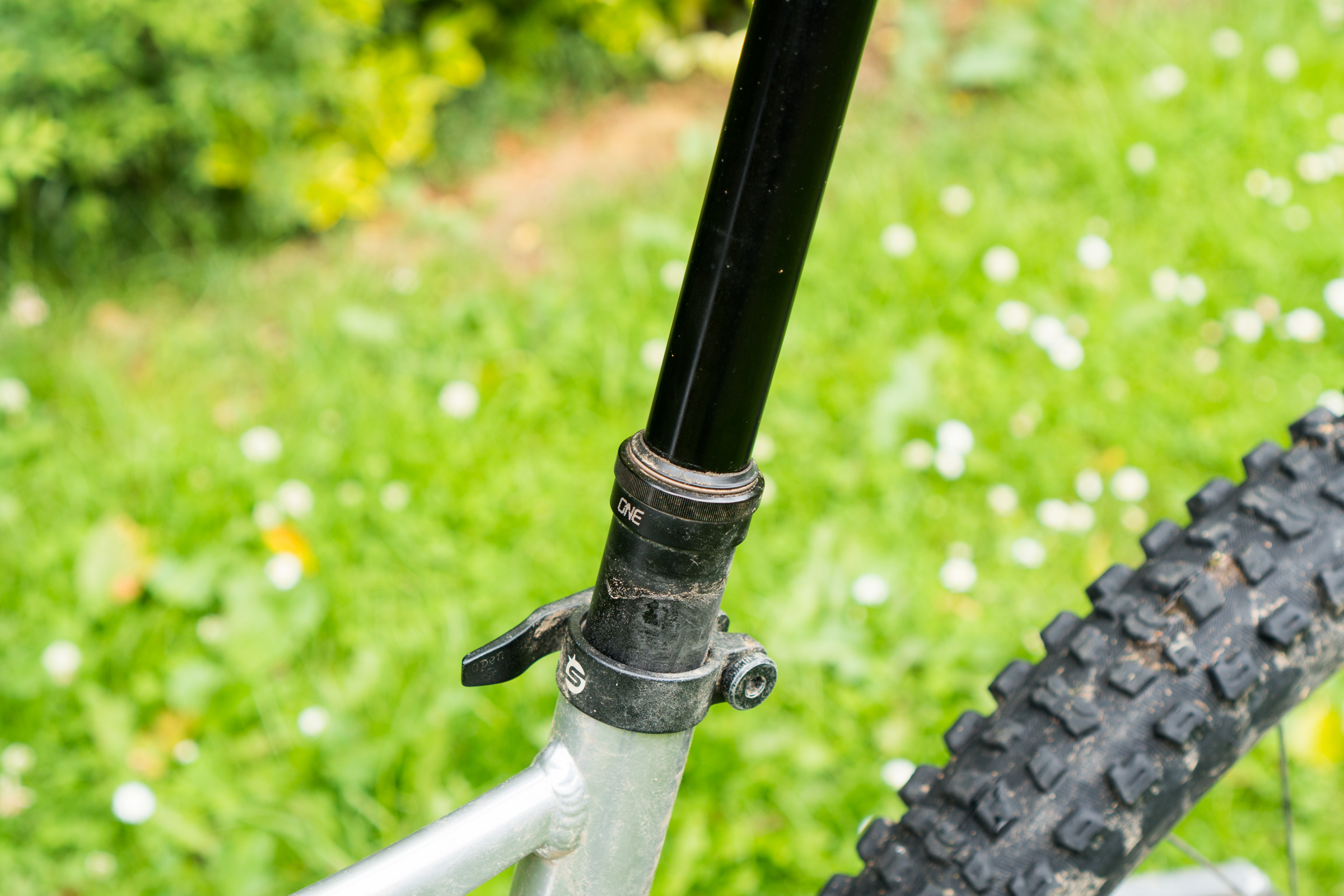
Longer-travel posts do exist, from 170mm up to 210mm, but they can be difficult to use for shorter riders or on certain bike frames. That said, longer-travel posts are becoming more and more common as technology improves and bike manufacturers design frames with shorter seat tubes.
To figure out how long a drop you can use, measure your existing seatpost from the saddle rail to the top of seat collar, then compare this to the length of the dropper post from the saddle rail to below the post's collar.
If the number is the same or less, you're in business. If the dropper post's length is longer, you'll have to use another option.
Fixed or infinite travel adjustment?
There are two travel styles for dropper posts: those that have fixed height settings where the post stops (20mm down, 75mm down, etc), and those that do not, often referred to as stepless or infinitely adjustable.
Stepless posts enable you to stop the saddle anywhere within the post’s travel range. The majority of posts on the market are stepless designs.
Dropper seatpost internal workings

All posts require some sort of spring to return the saddle to the fully upright position and a locking mechanism to hold it in place.
Early designs simply used coil springs and pins to do the job, but these were less refined and often returned the saddle back towards your bottom at an unnerving speed.
You can still find mechanically locking designs with an air spring, but most dropper posts now use a fully sealed hydraulic cartridge that contains both a pressurised charge and a mechanism that allows the adjustment.
There are a number of advantages to this, namely that the body of the post, which needs to cope with very heavy loads, doesn't also have to be airtight and so lower-friction seals can be used for a lighter action.
If something does go wrong with the post, it's also much quicker and easier to switch in a replacement cartridge rather than repairing the entire post.
Dropper seatpost remotes

On most droppers, lowering the saddle is done by a handlebar-mounted remote.
The remote lever commonly sits under the bar, taking the place of the front shifter paddles on bikes equipped with a single-ring drivetrain. On bikes with a front shifter, remotes that integrate into the lock-on grip collar or sit above the bar are available.
SRAM's Matchmaker and Shimano's I-Spec standards allow you to combine a dropper and brake lever on one mount to keep the handlebar tidy.
On bargain-priced dropper posts, the lever may be just under the saddle on the post's head. The obvious downside to this style is having to take a hand off the bar, something you don't want to do when riding into a section worthy of dropping the saddle.
Most remotes on the market use a cable to operate them but some, such as the RockShox Reverb, use a hydraulic system.
There are drawbacks and benefits to each. Cables are cheap and easy to replace if they fail, but over time they become stiffer to use as dirt enters them.
That isn't a problem for hydraulic units, but they are much harder to fix should you damage one in the field.
Cable routing

The overwhelming majority of dropper post cables are internally routed. This requires a hole in the frame to route the cable up through the seat tube – virtually every modern mountain bike, and the latest gravel bikes, have this option.
The other cable option is an external cable that either attaches at the dropper post's collar or up at the head where the saddle attaches.
The benefits of an internally routed cable include clean looks, better protection from dirt and debris, and zero cable movement when dropping the post. But, like any internally routed cable, set up can be tricky, and swapping cables and housing can be a chore.

The upsides to an externally routed cable are compatibility with any frame and a simpler setup. The negatives deal primarily with cables that attach to the seatpost head, because the cable can interfere with the bike's rear tyre or hit your leg if not routed carefully.
The final option does away with the cable completely – the RockShox Reverb AXS is an example of a dropper post that uses a wireless, electronic system. Removing the mechanical cable from the equation makes installation easy and also makes swapping the seatpost from bike to bike a reality, provided they share the same seatpost diameter.
Gravel dropper seatposts
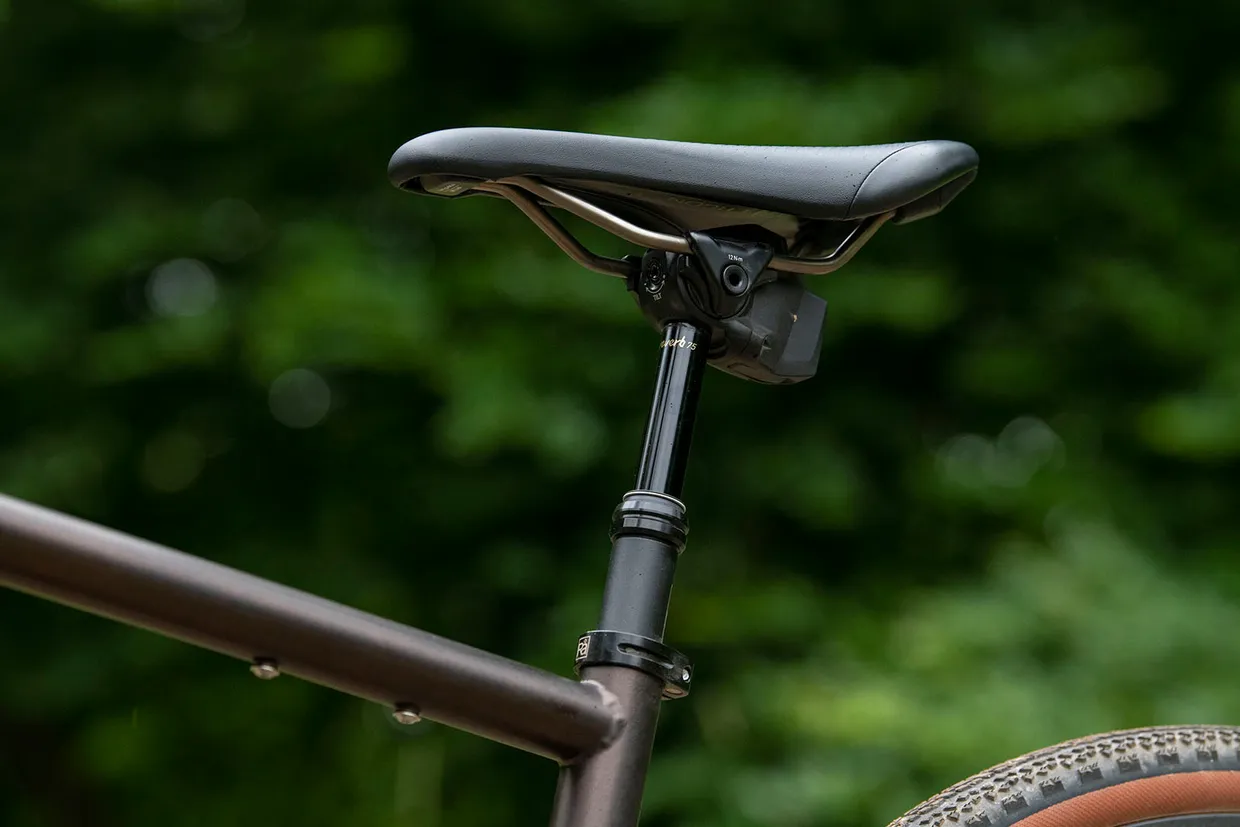
Gravel bikes have started to adopt dropper seatposts to clear room for you to move around on technical descents.
They are usually a thinner diameter than on mountain bikes, with this leading to smaller travel drops, which is less of an issue with gravel bike geometry.
Some of the best gravel dropper posts will feature a small amount of suspension to smooth the ride when seated, such as RockShox's Reverb AXS XPLR.